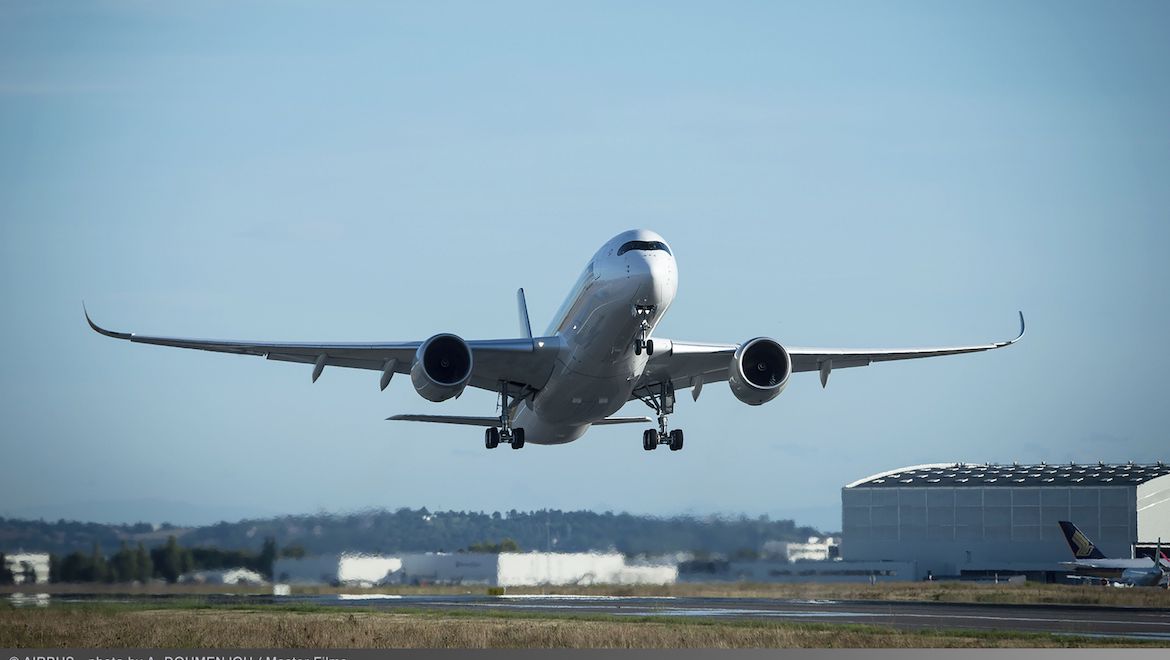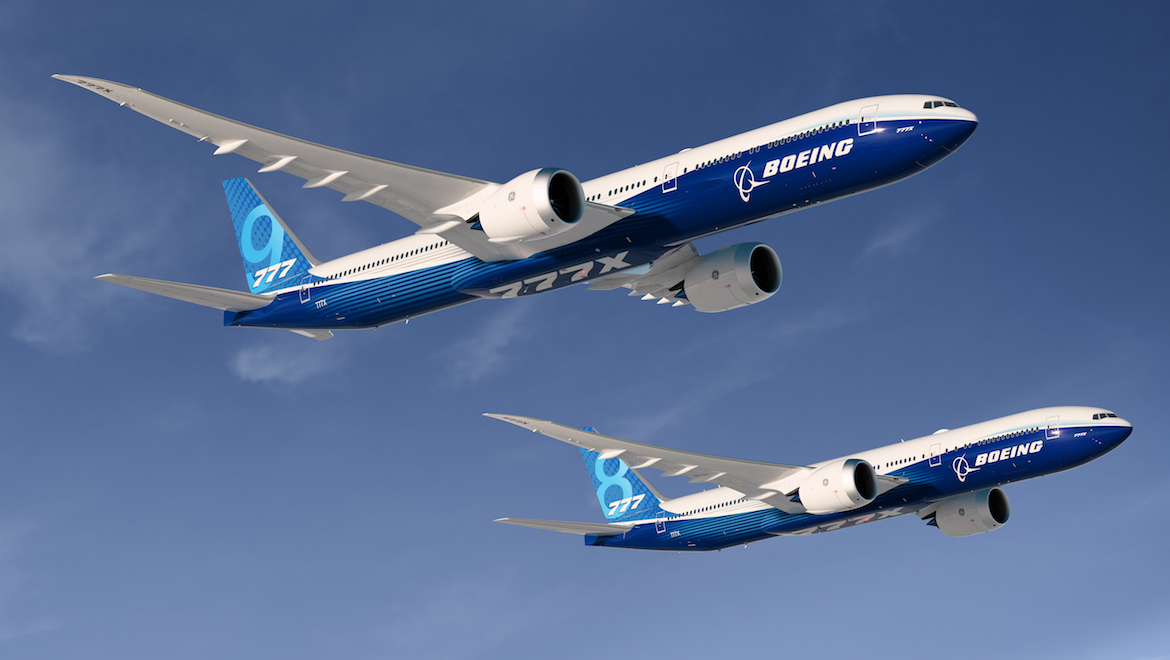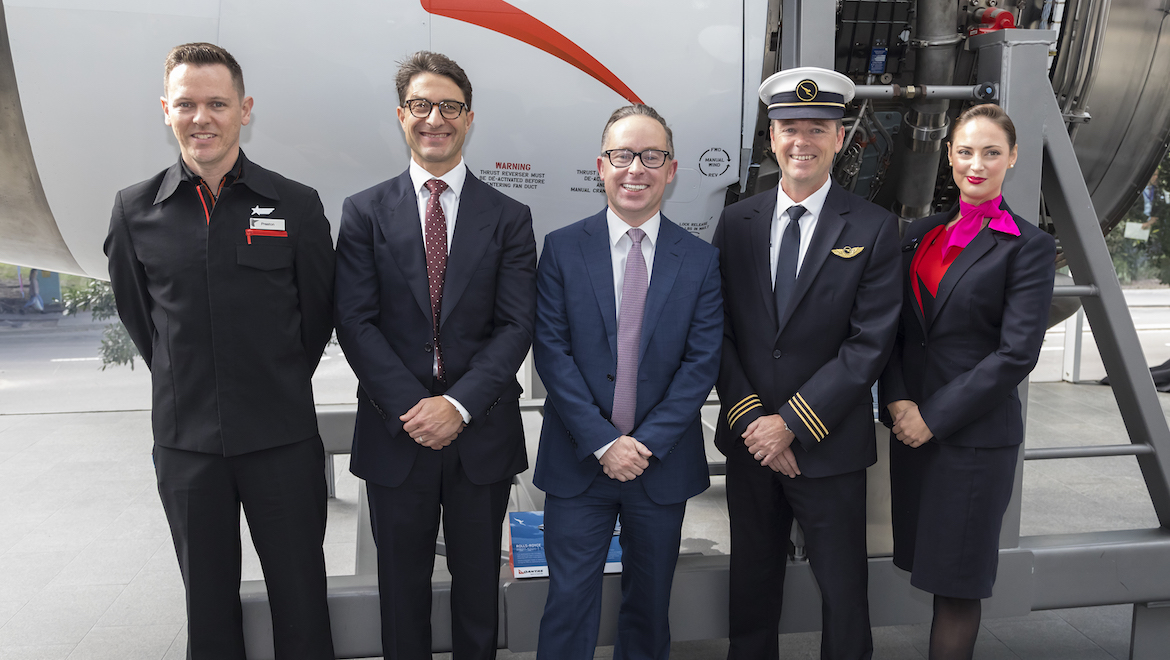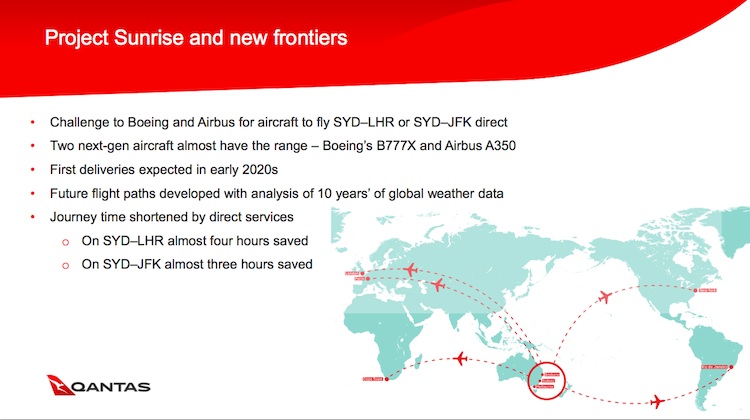This story about the process behind the Project Sunrise evaluation at Qantas first appeared in the May 2019 edition of Australian Aviation.

When Qantas first laid down its Project Sunrise challenge in August 2017, the name evoked memories of Catalina flying boats operating during World War II.
The flights between Perth and the country now known as Sri Lanka lasted up to 32 hours, meaning those on board experienced a “Double Sunrise”.
Since Qantas called on Airbus and Boeing to come up with an aircraft capable of flying nonstop from Australia’s east coast to London and New York, among other places, these potential ultra long-haul routes have captured the attention of aviation enthusiasts the world over.
If enthusiasm and public opinion were all that mattered, Qantas would probably have already put pen to paper for either the Airbus A350 or Boeing 777-X.
However, Qantas chief executive Alan Joyce says sentiment will play no role in determining whether Project Sunrise goes from concept to reality, with the decision process similar to that of any other potential aircraft order.
“Sunrise is not different from any other fleet decision,” Joyce told Australian Aviation in an interview
at Qantas’s Mascot headquarters in late March.
“You make the fleet decision on the basis of ‘will it meet the economics, will it cover its business case’? And then you decide on the configuration that best suits your network.”
Qantas has said previously it was aiming to complete the Project Sunrise evaluation and announce a decision by the end of calendar 2019.
In the meantime, work is progressing on four key areas that will inform the airline on whether to proceed – the right deal from the manufacturer, agreement with the pilots union, the go-ahead from the regulator and coming up with the right onboard products.
AIRBUS AND BOEING HAVE THE AIRCRAFT CAPABLE OF SERVING THE ROUTE
In 2018, Qantas conducted a request for information (RFI) with Airbus and Boeing that went through the technical capabilities of the A350 and 777-X platforms.
Notwithstanding the prospect of further developments with both aircraft platforms, the RFI process concluded that what Airbus and Boeing could offer would be able to operate with what Joyce described as a full payload between Sydney and New York.
For Sydney-London, Joyce said the aircraft would not be able to operate with a full payload. Instead, the manufacturers told Qantas they were able to achieve a payload that made the business case potentially work.
“The aircraft can do Sydney-New York no problem and Sydney-London with a commercial payload,” Joyce said.
“We now technically have a tick.”
Qantas has now opened a request for proposal (RFP) which asks Airbus and Boeing to supply a commercial deal that includes price, performance guarantees and details of potential delivery streams, among other matters.
Joyce said both companies were holding slots towards the end of 2022 into 2023 for any potential Qantas order.
Airbus has put forward its A350 platform to meet Project Sunrise’s objectives.
The A350-900ULR variant is already flying with Singapore Airlines (SIA) on the world’s longest route between Singapore and New York, which measures 8,285nm on the Great Circle mapper.
Airbus has said previously the A350-900ULR was capable of flying up to 9,700nm, or more than 20 hours nonstop, in a low-density configuration. SIA has configured its seven A350-900ULRs with 67 business class and 94 premium economy seats for a total of 161.
Airbus has also floated improving the performance of the A350-1000 variant to bring it into consideration for Project Sunrise.


Meanwhile, Boeing’s 777-X platform is yet to fly. The most likely variant for Project Sunrise is the 777-8X, which is still in development.
The aircraft is listed on the Boeing website as having a range of 8,690nm with a two-class cabin seating between 350 and 375 passengers. Entry into service was expected in 2022.
Joyce said it was of no consequence the 777-8X was still in development compared with the A350-900ULR and A350-1000, which has been in commercial service since October 2018.
“We picked the 707 before it was a real aircraft. We picked the 747 before it was a real aircraft,” Joyce said. “We picked the A380 before it was a real aircraft.”
“The fleet planners are pretty good. Boeing are not at a disadvantage because this aircraft is an aircraft that is there on paper.
“They have to guarantee on the RFP process performance issues. We are pretty good at evaluating the technical data. Just because one is physical and one isn’t, there’s no difference.”

PILOTS AND FATIGUE
Qantas is also keen to secure a new work contract, or enterprise bargaining agreement (EBA), with its pilot corps before any order is made.
The current EBA for Qantas’s long-haul pilots is currently open and the airline is taking a similar approach to its discussions with unions as it did with the Boeing 787 order in 2015, when the company sought productivity improvements and other changes ahead of committing to the Dreamliner.
“We’re having an open book program with the union to talk about, here is the business case, here is where it stands, here is what we need in terms of changes to make it work and having that dialogue with them,” Joyce explained. “That process will take a number of months.”
“They are very excited about the aircraft. They think it is going to be great for them in terms of growth; they think it is going to be great for them in terms of this operation.”
While pilots are indeed supportive of Project Sunrise, Australian and International Pilots Association (AIPA) president Mark Sedgwick described their mood as “cautiously optimistic”. AIPA is the union representing Qantas pilots.
“For us, we are supportive of the project,” First Officer Sedgwick told Australian Aviation in an interview on April 4.
“We feel that these aircraft are going to be important to the future of Qantas, mitigating its end-of-line carrier status, overflying hubs and allowing us to really bring international into its own.”
“We think the value to Qantas and the strategic benefit goes beyond this pilot EBA negotiation. Obviously we are willing to negotiate and discuss how they feel our contract may assist, but the strategic benefit to Qantas is clear and transcends the pilot contract in itself.”
Beyond the EBA, AIPA is also keen to ensure the fatigue risk management system (FRMS) will underpin the safe operation of these ultra long-haul services. Figures Qantas published in August 2017 indicated Sydney-London would have a flight time of 20 hours and 20 minutes, while Sydney-New York would be 18 hours and seven minutes.
AIPA representatives recently visited Airbus and Boeing to inspect mockups of the crew rest area for the A350 and 777-X and First Officer Sedgwick said being able to get good rest on these long sectors would be a significant focus.
“For the pilots in the operating seat after a 20-hour plus flight, if you are arriving in the northern hemisphere in bad weather clearly you are going to need peak performance. So the on-board rest will be vitally important.
“For us it is about making sure that any FRMS is truly data driven so you can become agnostic about particular absolute rules, but it must involve real scientific analysis and pilot involvement and there is more work to do there.
“It is about identifying the risk and having the right mitigators for those risks. And those risks will be identified by data as well so you have to have a good pool of data and a good feedback system.”

ENTER THE REGULATOR
Australia’s Civil Aviation Safety Authority (CASA) also has a role, given its rules on fatigue have to be updated to allow Qantas to operate these Project Sunrise flights.
While maximum duty hours for pilots and cabin crews is set at 18 hours, CASA has allowed Qantas’s Perth-London Heathrow an exemption that increases the limit to 19 hours and 50 minutes and adds other mitigation measures specific to the route.
The regulator will have to move even further for nonstop flights from Australia’s east coast to London and New York.
A CASA spokesperson told Australian Aviation in an emailed statement the regulator was monitoring fatigue management approaches for current ultra long-haul operations, including detailed fatigue studies.
Further, CASA attended Qantas Fatigue Safety Action Group meetings as an observer and had access to operator fatigue reporting data.
“Qantas and AIPA are sponsoring a detailed fatigue study of the Perth-London route by Monash University and actively monitoring fatigue reporting in the Fatigue Safety Action Group,” the CASA spokesperson said.
“The data from these studies will be critical to understanding the fatigue management approaches for any proposed further extension of flight duration such as Project Sunrise.”
VIDEO: A look at the 777-X flight deck published in 2017 on the Boeing YouTube channel.
Joyce said the discussions with CASA would build on what had happened in the past, including the Perth-London nonstop flights that began in March 2018 and other long-haul operations before that, such as nonstop flights from Australia to the United States mainland.
“We are obviously having to talk about the regulator, about changing the regulations or having the regulations suitable for this long-haul flying and what does it mean for fatigue risk management for both pilots and cabin crew and how is the company going to manage that,” Joyce said.
“So there shouldn’t be anything that is uniquely difficult about it. It’s typically what we have done when we have extended the operation each other time.”

SLEEPING BERTHS AND SPACES
While the prospect of 300 seats in four classes, which Qantas had floated in 2018 as a desired cabin configuration, now appears unlikely, the airline is still exploring how to include other amenities on board the aircraft that will eventually operate these routes.
A recent survey of Qantas frequent flyers showed their top five suggestions included having a “sense of separation” experience such as a virtual relaxation zone, an exercise area, wireless noise cancelling headphones, cabin designs with both seat and non-seat spaces, and an inflight cafe.
“You are designing something that is very different. You are designing something for 21 hours,” Joyce explained.
“That’s why first class and business class comes into it. That’s why you are probably going to have a higher configuration in those classes, that’s why you start looking at some of the space that you can’t use because the payload-range doesn’t allow you to do it and you come up with ideas, concepts that make better use of that and that’s when all of these come onto the table.
“You don’t rule anything out and anything in at this stage, this is a concept evaluation.”
The survey of Qantas passengers on the Perth-London Heathrow nonstop service was conducted in partnership with the University of Sydney’s Charles Perkins Centre, which has been working with Qantas on improving the passenger experience on that flight.
And those initiatives, such as the lighting design, food service and cabin temperature – along with the in-built features on the 787 – appear to have won over the customers, with Qantas saying the QF9/10 Perth-London rotation had the highest customer satisfaction across the airline’s network.
Qantas industrial designer David Caon said ultra long-haul flights envisaged in Project Sunrise would push the boundaries of product innovation.
“Customers are sharing some incredibly imaginative ideas, which is an exciting challenge and helps us to think outside of the box to redefine the ultra long-haul experience,” Caon said in a statement on January 28.
“Bringing some of these concepts to life will involve an entire rethink around how to be clever about use of all cabin space and what is practically possible but it may well involve incorporating design elements never before seen on commercial aircraft.”

On top of all the other challenges that ultra-long haul flights come with, Qantas has also spoken previously of having the aircraft be suitable for not only nonstop service from Australia’s east coast to London and New York, but also flights to destinations in its existing network such as Hong Kong and Los Angeles.
In that sense, potential aircraft order represents both an opportunity for growth and the replacement of other aircraft in the Qantas fleet.
“There are some routes that we have today that are just going to be superseded by better technology,” Joyce said. “And there is some routes that we don’t have today that are going to be added to the network.”
“Part of Sunrise could be replacement and part of it could be growth.”
VIDEO: A closer look at the Airbus A350-100 from the Airbus YouTube channel.
FLYING FURTHER VERSUS FLYING FASTER
While Qantas has set its sights on what some have called the Holy Grail, there are others who regard speed, not endurance as the ultimate challenge in aviation.
One of those is former Virgin Australia chief executive John Borghetti, who stepped down in March 2019 after nine years at the helm of Australia’s second largest airline group.
Speaking to the No Limitations podcast in an October 2018 interview, Borghetti said he was in no doubt that supersonic flight would be a reality sometime in the 2030s.
“People don’t want to spend 24 hours on an aeroplane going to London, they really don’t,” Borghetti said. “People want to get to the destination as quickly as possible.”
“You look at technology and you say well, what about if we could go faster? What about if instead of taking 22 hours to London we can do it in 14 or 15, pick a number. Does it really matter if you stop twice or three times if you can get seven hours off your flight? The answer is no.
“Imagine if you could build a Concorde today that was a composite fibre aircraft that’s got engine technologies of today that can carry – I will pick a number – 100 people, 150 people. What would the airfares be for that to operate and you will find very quickly the airfares are a lot cheaper than obviously the Corcorde airfares, and pretty well in parallel with some of the business class that are here now.”
Borghetti, who conceded his view was a bit of an outlier in the aviation industry, said Virgin Australia had been talking to Denver-based Boom Supersonic. Boom is developing a supersonic aircraft capable of reaching speeds of Mach 2.2 and flying one-stop between Sydney and Los Angeles in seven hours, including the time required for a fuel stop. Entry into service for the aircraft is forecast for the mid-2020s.
This story first appeared in the May 2019 edition of Australian Aviation. To read more stories like this, become a member here.
















Maria Wright
says:Agree with Borghetti. No-one wants to be stuck between two people in a seat that doesn’t allow you to put your legs up for over 20 hours. Despite what Joyce is saying, I am not sure all Qantas fliers are happy being forced to make the 5 hour trip across the country, off loaded for hours before being able to pick up the 20 hour direct flight to London.
Bring on the faster trips!
Sam
says:With fuel prices going up and the tone of Joyce at the IATA Seoul conference (paraphrased, if the business case isn’t right we won’t do it), it wouldn’t surprise me if this project didn’t get off the ground.
Esmerelda
says:Hmmmm… 7 hrs on a supersonic jet at Mach 2.2 or 13 plus hrs non stop on a flying caravan?
MERVYN CROWE
says:Airlines all over have forgotten about the dreaded”DVT” that was prevalent and highlighted many years ago.
If you choose to go on one of these ultra long flights, then enough room absolutely has to be made available to you to stretch your legs, and that may mean, less seats on the aircraft. QANTAS and EMIRATES particularly need to remind their cabin crew that it is actually ok to go for a walk round the aircraft to help alleviate the DVT issue. Cabin crew snarl at you as if you are in the way, and show displeasure when you do go for a stroll.
If QF do ever operated the 777x or A350ULTRA from SYD/MEL TO LHR, then we here in PER will get the flick with the daily B787 service. Frankly I cannot see the problem of an hours break in SIN, KUL or DXB en route to Europe, stretch the legs go to a real toilet and freshen up.
Ann OEDING
says:Cabin Crew don’t snarl….in flight ssfety…..QF72 those with seat belts on survived unhurt. 200 pax wandering around cabin & hit air turbulence…..imagine !!!!
Adrian P
says:Supersonic is the way to go. No need to stop, in-flight refueling is well established with tankers and receivers (AEWs) based on airliner air frames. Not forgetting Virgin Galactic and other suborbital options.
Alex Vari
says:What are these guys thinking?
Bring on the old days.
Even twelve leisurely stops along the way.
A mini golf course.
Real cooked meals with real cutlery.
Strolling room to spare.
Dig out those old posters.
The holiday begins when you step on the plane.
SP
says:Borghetti is thinking correctly, speed, time in the air, is the real challenge. 20 hours in any aircraft v 14 with a stop – the 14 hour trip will always win. It was done before, it can be done again and better. Joyce failed with the 380 choice, the international business can’t get in wrong again.